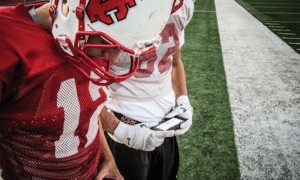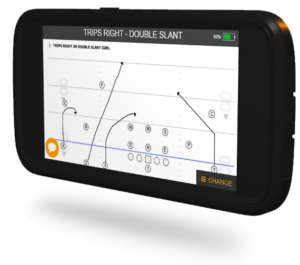How to Improve Your Football Drills with GoRout
Reading Time: 11 minutes
Reading Time: 11 minutes
Effective football drills play a critical role in player development and team success. However, relying solely on traditional methods can hinder progress.
To maintain an edge, coaches must continuously evaluate and refine their drills to ensure alignment with current player capabilities, technological advancements, and the evolving game itself.
One good example is the controversial “Mat Drills“, formerly used by the Georgia Bulldogs. While the drill once fostered team cohesion, it has been identified as lacking in its ability to improve agility, footwork, and other tangible player skills.
As coaching methodologies and resources evolve, innovative solutions like the GoRout coach-to-player communication system present exciting opportunities.
Our technology facilitates real-time on-field communication and optimizes football practice, enabling coaches to tailor drills to individual strengths and weaknesses.
You can move beyond a one-size-fits-all approach and create a coaching practice that unleashes the full potential of your players.
In today’s article, we will discuss the role of football drills in team development, share 45 types of football drills to inspire you, discuss common coaches’ challenges and solutions, and show you how to use the GoRout football practice solution in your drills.
Let’s get started.
The Role of Football Drills in Player Development

Football drills are the foundation for player growth and team synergy, impacting individual skill refinement and collective team performance.
Drills are crucial in helping individual players address weaknesses and hone fundamental skills through targeted focuses. They cultivate communication, coordination, and adaptability, preparing athletes for high-pressure game scenarios.
Collective accountability in football drills fosters a culture of responsibility, contributing to a team’s adaptability, agility, and versatility.
Psychological benefits among teammates include:
- Building confidence
- Overcoming challenges
- Enhancing concentration and focus
- Fostering teamwork and communication
- Developing leadership qualities
- Instilling a growth mindset
Ultimately, football drills serve as the forge for developing champions and shaping players and teams for success on the field.
45 Types of Football Drills to Implement Today
Let’s explore diverse and effective types of football drills you can implement to enhance individual skills, foster teamwork, or address specific aspects of the game.
These drills cover a spectrum of objectives to suit your coaching needs.
Position-specific football drills

Quarterback drills
- Three-step drop drill
- Virtual reality decision-making simulation
- Pocket presence drill
- Two-minute drill
- Sprint out
Imagine a football team trailing by four points with only two minutes left. The offense, led by the quarterback, needs to drive down the field to score a touchdown and secure the win. They will need to have excellent decision-making and passing accuracy skills.
Quarterback drills develop accuracy, arm strength and power to throw the ball effectively. They also improve ball control.
Quarterbacks are the offensive team leaders and need these quarterback drills to evade defensive pressure and throw on the run.
Running backs drills
- Ladder drill
- The jump cut
- Cone hops
- Line response drill
- The jump cat
A football team relies on versatile running backs who can excel in traditional rushing plays and be a potent threat in the passing game.
A running back’s success is measured by rushing yards, their ability to receive the ball, and their body control.
A running back drill focuses on both speed and agility. The five football drills mentioned above will help running backs avoid tackles, make cuts, catch passes and be efficient in the red zone.
Offensive line drills
- Virtual reality engagement drill
- Bull in the ring
- Set and punch
- Mirror
- Shuttle
A football team with a strong emphasis on a passing offense relies heavily on the offensive line’s ability to protect the quarterback. The offensive linemen must give them the time to make accurate throws and execute successful passing plays.
It is where offensive line drills come in handy.
The main job of the offensive line is to protect the quarterback. This position has much physical contact. Therefore, they have to deliver strong initial contact and control their bodies. The best way to practice their stance and position is by repetition in practice.
Defensive line drills
- Shedding blocks
- Goal-line stand
- Scramble drill
- Pass rush techniques
- Hand fighting
If a football team prioritizes disrupting the opponent’s passing game, then the success of defenders on the team hinges on the defensive line’s capacity to generate a consistent pass rush. It leads to quarterback pressures, sacks and disrupted plays.
Defensive linemen also have a very physically challenging role on the field. They focus on getting sacks and tackles as well as their three-point stance. Defensive drills aim to assist them when shedding blocks and pursuing the football.
Linebacker drills
- Cutback drill
- Pursuit drill
- Blitz drill
- Backpedal and shuffle
- Angle drill
The team’s success relies on a linebacker’s capability to read plays and react swiftly. Teams appreciate linebackers who can effectively read the opposing offense, make accurate decisions, and contribute to both run defense and pass coverage.
The linebacker drills focus on improving speed, vision and tackling. Linebackers are leaders of the defense. They must have great vision and react quickly and intelligently when reading the play.
Wide receiver drills
- Cone footwork drill
- Hide and seek
- Technology running analysis
- Wall ball control
- Catching in traffic
Imagine a Super Bowl matchup where a team has only one opportunity to make a comeback. With just over two minutes on the clock and the team trailing, the offense is in a critical “two-minute drill” scenario.
Receivers recognize shifts in defensive coverages and adjust their routes accordingly, exploiting openings in the defense. Bam! Touchdown, and that’s the game.
Wide receivers have to be some of the fastest players on the team. They must run clean routes while making accurate catches and maintain control.
Football drills help them with reaction speed and time, catching and footwork simultaneously.
Team football drills

Tackling drills
- Angle pursuit drill
- Strip and rip
- Lift drill
- Sideline tackling
- Mirror drill
A football team is preparing to face a powerful and physical running back like Tennessee Titans’ Derrick Henry, who can break through initial contact.
The success of the team’s defense relies on the ability of multiple players to converge on the ball carrier, swarm effectively, and bring them down with coordinated tackling.
Every defensive player who plays football must be prepared to tackle to get the win. These tackling drills teach players to explode out of their stance, wrap up ball carriers and attack their opponents from any direction or field position.
Agility drills
- High knees
- Shuttle run
- Box drill
- 3-cone drill
- The flying 30
The team’s success hinges on the ability of their defense to contain the receiver and limit his yards after the catch. These five football drills will help a team improve speed and agility among all team members regardless of their position.
Conditioning drills
- Four corners
- Cone-to-cone sprints
- Sled drags
- Interval sprints
- Strides
Many football teams consistently face challenging fourth-quarter situations. Whether leading or trailing, their ability to dominate the final quarter becomes a defining factor of success. It attributes to a team’s exceptional conditioning, developed through rigorous conditioning drills.
Conditioning drills are the foundation of a peak-performing team’s skills. They help build stamina, advance fitness and encourage team camaraderie. There’s nothing like interval sprint practice to unify all players.
How Effective Drills Contribute to Football Team Success

Effective football drills contribute to team success by refining individual skills while promoting teamwork and communication. They enhance adaptability, build endurance, prepare for specific game situations and reduce injury risks.
Teams prioritizing well-designed practice drill regimens establish a strong foundation for sustained success. Players develop the necessary skills, coordination and resilience to perform at their best during games.
Here are some real-life examples of how well-designed football drills can directly influence success on the field.
1. New England Patriots (NFL) and the two-minute drill
The New England Patriots and head coach Bill Belichick are renowned for one of their staple practice drills, the “Two-Minute Drill“. This drill simulates end-of-game or end-of-half scenarios.
It sharpens individual decision-making and enhances team coordination, clock management and situational awareness skills. The Patriots’ success in close games and late-game situations is often attributed to their proficiency in these drills.
2. Alabama Crimson Tide (college football) and fourth quarter program
Alabama’s “Fourth Quarter Program” is a legendary conditioning regimen emphasizing physical and mental toughness. It involves high-intensity conditioning drills and workouts designed to simulate the demands of late-game situations. Alabama’s consistency in crucial game moments reflects the team’s resilience and stamina developed through these rigorous football drills.
3. Baltimore Ravens (NFL) and Ravens tackling circuit
The Baltimore Ravens and head coach John Harbaugh prioritize tackling proficiency through the “Ravens Tackling Circuit.” This drill focuses on attacking techniques and angles. Thanks to this drill regimen, the Ravens have a reputation for solid tackling and run defense.
Common challenges faced by coaches in conducting drills
As a coach, we know you face some challenges during drill sessions at practice. These challenges can range from a lack of player engagement or practice time to disparities in skill levels and injury concerns.
These problems often result in uneven player development, frustrated team members and damaging morale.
Here are some solutions you can implement to mitigate these challenges:
- Variety in drills
- Efficient time management
- Injury prevention programs
- Effective coach-to-player communication system
- Gradual progression
- Regular equipment updates
- Clear feedback mechanisms
Addressing these challenges requires evaluating each player and their performance to have a keen understanding of their needs.
NFL Head Coach Nick Sirianni of the Philadelphia Eagles has done a great job adjusting quarterback Jaylen Hurts practice drills in light of his ankle injury in the 2023 season.
Hurts is taking fewer reps during practice. He is acting as a part-time coach to his backup quarterback. It’s a win-win.
How to Use GoRout in Cross Team Periods

A coach must maximize practice time to enhance each player’s skills and performance. It involves increasing repetitions, dedicating more time to teaching, and creating additional development opportunities for the team.
The GoRout play-calling system emerges as the best sports team communication app, offering precisely these benefits.
Our football coaching software includes a coaches’ app and robust wearable devices. It helps you streamline practice sessions, improve player execution, and give your team a competitive advantage on game day.
How GoRout Football Practice System Works

Let’s explain the mechanisms and features that make the GoRout system a game-changer for football teams.
GoRout Scripting App

Practice planning just got a significant upgrade. Forget hand-drawn cards and messy spreadsheets. Use the GoRout Scripting App – your digital command center for efficient practice sessions.
Why go digital with GoRout?
- Seamless integration: Use your existing card drawing software and import any image file or PDF document without switching apps.
- Effortless organization: Edit, copy, and organize practice scripts with ease.
- Increased flexibility: Copy, move and flip plays between periods and adjust drills instantly.
- Access anywhere: Work from any device thanks to Google Chrome compatibility.
- More time for coaching: Spend less on planning and more on inspiring your players.
Save time and efficiently prepare for every practice period with just a few simple clicks.
On-field practice app

GoRout on-field practice app helps coaches run effective practices and streamline communication with each player. It’s available on iPhone, iPad, and Android devices.
- Instant formation transitions: Eliminate time-consuming formation changes with a single tap on the screen. Keep players focused and maintain practice momentum.
- Seamless play review: Flag plays for immediate review with a single touch. Quickly identify areas for improvement and adapt drills on the fly.
- Live card editing: Draw directly on the screen to make real-time adjustments to any play. GoRout adapts to your coaching flow, not the other way around.
- Organized practice flow: Start, end, and easily organize practice sessions. Send plays directly to players’ devices.
- Enhanced communication: Ensure everyone is on the same page with clear, consistent messaging. GoRout keeps coaches and players in sync for optimal practice effectiveness.
GoRout is more than just an app; it’s a coaching partner. Experience the difference that streamlined practice and clear communication can make.
Spend less time on logistics and more time on coaching.
Wearable player devices

Forget cumbersome headsets and unreliable Wi-Fi. GoRout’s wearable player devices are plug-and-play simple, requiring no setup.
Select your practice group, and players are instantly ready to receive plays. A discreet vibration alerts them to new instructions, ensuring everyone’s on the same page without breaking the flow.
Each device has a 100% warranty against breakage, protecting your players and equipment.

Here’s how you can integrate GoRout into your practice:
- Run more plays with scout teams
- Walkthroughs and football drills
- 7 on 7 football
- Special teams (KO, KOR, P, PR)
- Preparing against up-tempo teams
- Reducing install times for new players
Data shows that teams average 3X more reps with GoRout’s wearable technology. It leaves more time for teaching and development drills during practice.
Evaluating and Adjusting Football Drills
Evaluating football drills is essential for coaches to gauge the effectiveness of skill development, make smart decisions based on data-driven insights and track individual player progress over time.
Some sure indicators that show the effectiveness of a football drill include skill mastery, game performance, speed and reaction time, physical fitness, injury rates, and drill efficiency.
You need an efficient practice system like GoRout to effectively track and evaluate your football drills.
Say your players are doing a team-oriented drill where players throw and receive passes while working to improve their footwork. By doubling the reps using GoRout, it becomes clear that the team lacks communication and coordination.
As a coach, you decide to change direction and make modifications so the drill focuses on teamwork, communication and positional understanding. As a result, your players learn to be more cohesive on the field.
Crafting Progressive Training Sessions
Coaches should prioritize open communication by establishing channels for player feedback and creating a collaborative coaching environment.
Using anonymous surveys, post-training debriefs, and regular team meetings allows players to express their thoughts on training sessions, coaching strategies and team dynamics.
Incorporating sports technology like video analysis tools enhances the feedback process.
Variety in football skills training sessions is paramount to keep players engaged and motivated. Coaches can infuse freshness and excitement into training by incorporating innovative drills that challenge players mentally and physically.
Some innovative drills include:
- “Chaos Drill” where players adapt to unpredictable scenarios, enhancing decision-making and adaptability.
- “Skill Circuit” is a dynamic circuit of skill-specific stations that adds variety and addresses individual player needs.
- “Incorporate Tech Challenge” introduces technology by using wearables or virtual reality.
Coaches keep training sessions vibrant while catering to different learning styles and preferences by embracing diverse drills.
Managing Player Burnout
Player burnout can be a huge problem in football. Recognizing player burnout—decreased performance, fatigue and mood changes—can help coaches control it.
Coaches can manage burnout by personalizing training plans, fostering open communication, incorporating structured rest and promoting a supportive team environment.
There is a delicate balance between intense training and providing adequate rest and recovery time. Sports psychologists like Dr. Jim Afremow emphasize the role of athlete well-being in overall performance.
They stress the importance of mental health and highlight that psychological factors significantly impact an athlete’s ability to cope with pressure, maintain focus and sustain motivation.
Success Stories of Top Football Coaches
Let’s explore the strategies that have defined the journeys of renowned coaches in the football world.
Bill Belichick (New England Patriots)
With 6 Super Bowl wins, he is known for his strategic approach and attention to detail. His training methods often involve situational drills that simulate game scenarios, emphasizing adaptability and decision-making.
Nick Saban (University of Alabama)
Saban is recognized for his focus on discipline and process-oriented training. His innovative methods often include drills that improve players’ technical skill levels within the broader team strategy. The team’s record under Saban is 201–28, with six national championships.
Sean McVay (Los Angeles Rams)
McVay is renowned for his innovative offensive schemes and strategic play-calling. His practices involve drills focusing on creating mismatches, improving quarterback decision-making, and emphasizing fast-paced matchups. He has led the Rams to five winning seasons with three NFC West titles.
Conclusion about football drills
Rehearsing football drills at practice is essential for a successful, well-conditioned team on game day.
Many great coaches—Bill Belichick, John Harbaugh, and Nick Saban—attribute their victories and skill levels to the various football drills in their practice sessions.
Coaches can use a football play-calling system like GoRout to diversify their coaching programs and keep their team on their game throughout the season.







